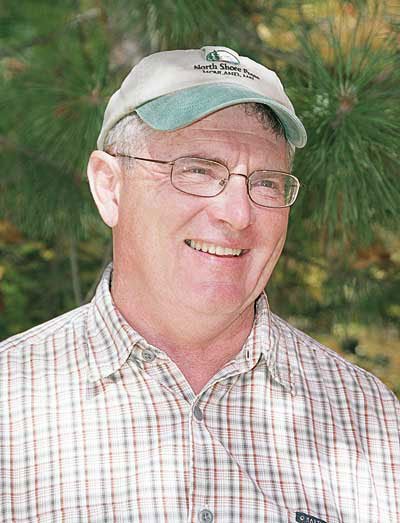The sounds of birds signal the coming of spring in the North. One morning in March you hear crows cawing when you step outside. Or maybe you hear a male robin cheerfully announcing his return to the still snowy landscape. Then juncos, last seen in late autumn, show up at the feeder.
But the sound that speaks to me most truly of spring is the whistling of goldeneye wings. One evening last week I took the dogs for a drive up the Arrowhead Trail just to hear it. There is a bridge across the outlet of McFarland Lake just above where it enters Little John; the next lake in the chain. The head of Little John stays open all winter, making it a magnet for river otters, mink and other aquatic-based wildlife. It’s the first place I see goldeneyes every spring.
I parked the truck and walked to the bridge, the dogs bounding ahead. Massive snowbanks lined the road and the forest was still buried beneath a deep-white blanket. No ducks were visible on Little John, so I just stood on the bridge and looked into the clear water. That alone made the evening drive worthwhile.
Then I heard a welcome sound overhead. I looked up to see a pair of goldeneyes cup their wings and splash down on the far side of the open water, more than 100 yards away. Having heard the wing beats of spring, I whistled to the dogs and took a short walk over to a firmly frozen McFarland. Up here on the Canadian border, we are a long way from ice-out.
The snow goes first along the south-facing ridges rising up from Lake Superior, usually weeks ahead of the forests just a few miles inland. I’ve been running the dogs along those North Shore ridges for a couple of weeks. Rainy, the year-old pup, has already found a small moose antler and a deer antler. I haven’t specifically trained him to find antlers, but they’ve been his favorite chew toys since he was teething. I let him keep both of the antlers he found.
Last Saturday, we went for a ramble on a nearby North Shore ridge that I hadn’t explored for some time, even though it was once a favorite hunting place. Maybe I was feeling nostalgic. Anyway, I knew the snow would be mostly gone. In the past, I found lots of deer antlers there.
The air temperature was well below freezing, so the remaining snow was as hard as concrete. Conditions were perfect for walking in the woods. We started out on a snow-covered, north-facing hill, walking a quarter mile or so until we reached a beaver pond. Over the years, beaver activity has waxed and waned. The last time I passed this way it was a grassy meadow. Now it looked like a small, frozen lake. I made a mental note to return in the fall to look for ducks and geese. Once, some years ago, I shot a limit of ducks there, an uncommon occurrence for north woods jump-shooting. The pond is presently so large it appeared that it might be difficult to sneak within shooting range of any ducks.
Across the pond I picked up an old road, which was barely discernible in places. The dogs, however, had no trouble following it. We walked past the place where I found my largest whitetail shed antler. Although I scoured the area looking for the matching side, I never found it. For years, the antler has been proudly displayed in my home.
Much of the land here is forested with jack pines that sprouted in the aftermath of a long-ago wild fire. Now they are large trees that create a park-like place with little underbrush. For me, it is reminiscent of the open, Ponderosa pine forests of the Black Hills. Sneaking through the jack pines was where I really learned how to still hunt whitetails.
We followed the road to the top of the ridge, where open rocky ledges were snow free. It was gone as well from the sunny spots on the south-facing slope. I left the road and wandered the hillside in search of antlers. Soon the dogs discovered the remains of a wolf-killed deer. Tanner, the old dog, came away carrying a foreleg. He paused now and again to gnaw on it.
Rainy appeared to be on the prowl for antlers, intently searching all of the bare ground. I did the same. In many places the rocky ground is covered with mosses, including a gray growth called caribou moss. Not surprisingly, this hillside was the last place woodland caribou were seen in Minnesota when a small band showed up during two winters in the early 1980s. They disappeared as mysteriously as they arrived.
We came to a place my hunting party knew as the Big Ravine. Rocky cliffs make it difficult to cross the ravine so places where it is possible to cross are natural funnels for deer. I stepped out on a ledge above one of those crossings and savored some hunting memories. I killed six deer over several years at that spot, including what may have been my heaviest buck. We never weigh out deer, but I thought about how difficult it was to get it out of there, even though most of route was downhill.
After crossing the Big Ravine, I started making a long loop back to the truck, hoping to find an antler along the way. That didn’t happen. Instead I found where a wandering moose recently had rubbed against a broken limb, leaving a double handful of hair on the snow. I looked closely for ticks, but didn’t find any.
We crossed the beaver flowage downstream from the big pond. Some of the ice looked a little sketchy, but Tanner made it across. Rainy broke through with a splash in a beaver run. I avoided his path and tried following Tanner’s route. But I weigh more than the old dog. I broke through with one leg and banged up my shin just below the knee. Even though it hurt, I smiled. Like hearing whistling goldeneye wings, breaking through rotten ice is a welcome rite of spring.



